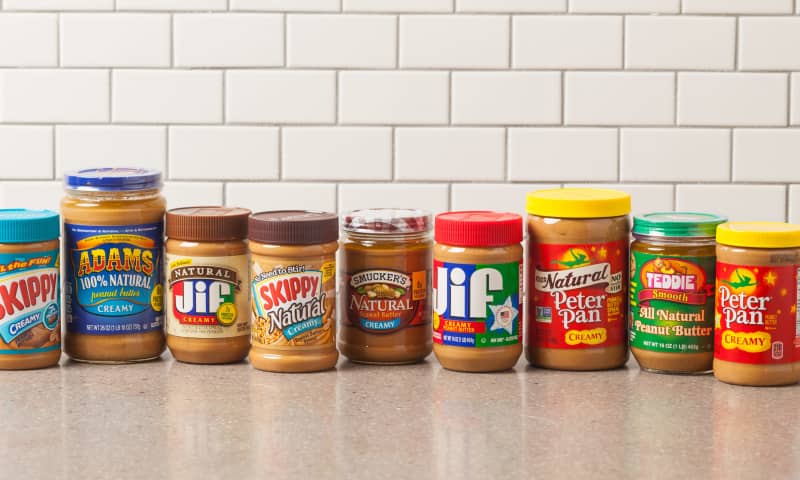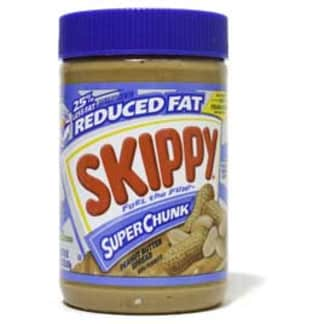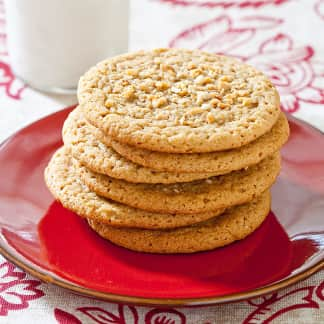Americans go nuts for peanut butter. Not just spread on PB&Js but also baked into cookies, pies, and cakes; swirled into brownies and frostings; and even stirred into soups and sauces.
There are a ton of options: creamy and crunchy styles, of course, but also flavored, organic, “no-stir,” and “natural” peanut butters. The last category has expanded significantly—with major brands, including Skippy and Jif, offering natural options, too.
For this tasting, we focused on creamy peanut butter since it’s more popular than crunchy and is the type we use most often in recipes. We tried nine top-selling creamy peanut butters—three traditional and six natural—plain, in peanut butter and jelly sandwiches, and in peanut butter cookies.

What Is “Natural” Peanut Butter?
At its most basic, peanut butter is made by grinding shelled, roasted peanuts with a bit of salt. However, the light brown, homogeneous peanut butter most Americans are familiar with is sweetened with sugar. And to create a product that’s spreadable straight from the jar, oils are added to keep the mixture from separating.
The products in our lineup fell into three categories. First, there were the aforementioned familiar peanut butters, made with hydrogenated vegetable oil and sugar, from Skippy, Jif, and Peter Pan. The second category consisted of peanut butters labeled “natural” that swap hydrogenated oils for palm oil. (Hydrogenated oils have been chemically treated to be solid at room temperature, while palm oil is naturally solid at room temperature, hence the label “natural.”) This category included Skippy Natural, Jif Natural, and Peter Pan Natural. The final category consisted of peanut butters made with just peanuts and salt, which were also labeled “natural” and included Adams, Teddie, and Smucker’s.
Tasters claimed they’d eat the peanut butter “straight from the jar.”
Oil Boosts Peanut Butter Texture
Once we tallied the results, our rankings were sorted almost according to type of peanut butter (hydrogenated oil on top, then palm oil, and then just peanuts and salt). Why the divide?
Products made from just peanuts and salt separate into two layers (dense solids topped by oil) and need to be mixed before serving. Even then, they don’t come close to the ultrasmooth texture of peanut butters with added oil; instead, they were largely thin, runny, and gritty, and they oozed out the sides of our sandwiches, while peanut butters with added oils stayed creamy and spreadable.

Type of Oil Matters When Baking with Peanut Butter
The type of oil in each peanut butter also made a major difference during baking. This is because saturated fats are solid at room temperature but start to liquefy when exposed to heat. So the less saturated fat a peanut butter has, the less it will spread when used in baking, and the more saturated fat it has, the more it will spread.
What is Hydrogenated Fat?
Hydrogenated fat is a fat that hydrogen has been added to in order to increase both physical stability and shelf life. Fats that are naturally hydrogenated are solid at room temperature and include many animal fats (such as butter or lard) and some plant fats (such as palm oil). Artificially hydrogenated oils are created through heating or catalysts. While all trans fats are hydrogenated, not all hydrogenated oils are trans fats. In the United States all products are required to declare any trans fat content on their label.
Peanut butters made with just peanuts and salt have naturally occurring peanut oil; compared with peanut butters made with added palm or hydrogenated oil, these products had the least amount of saturated fat: 2.5 grams per tablespoon. Cookies made with these simple peanut butters spread less during baking, turning out tall, cakey, and a bit lean-tasting. On the other end of the spectrum were peanut butters made with palm oil, which had 3.5 grams of saturated fat per tablespoon; cookies made with these products spread significantly, flattening into thin, crumbly disks. The best cookies were made with peanut butters that used hydrogenated oil, which has a comparatively moderate amount of saturated fat, 3 grams per tablespoon. Cookies made with hydrogenated oil peanut butters struck the perfect balance: They were rich and their texture was ideal—thick and chewy, with just the right amount of bend.
Smooth peanut butter is sold in three general styles: with no added oil, with palm oil, and with hydrogenated oil. While we think any homemade peanut butter cookie will be delicious, these products are not interchangeable and produce noticeably different results when baking. For a classic peanut butter cookie with thick and chewy texture, we recommend using a product with hydrogenated oil.
Tasters Want a Sweeter, Saltier Peanut Butter
While there is some natural sugar in peanuts, both the hydrogenated oil and the palm oil peanut butters add more in the form of granulated sugar or molasses. The difference amounts to about ½ teaspoon (or 2 grams) more sugar per tablespoon of peanut butter than is found in products made from just peanuts. Added sugar produced a brighter, more complex flavor, with tasters claiming they’d eat the peanut butter “straight from the jar.” These peanut butters also had a touch more salt—about 150 milligrams versus 105 milligrams of sodium per serving—which helped balance them against sweet jams in sandwiches.
The Best Peanut Butter Is a Classic
If you absolutely must have a peanut butter with no additives, we can recommend Adams Natural Creamy Peanut Butter, a West Coast offering that’s also available online.
However, for a truly great peanut butter for snacking and baking, stick with the tried and true. Once again, our favorite peanut butter was Skippy Creamy Peanut Butter; it had just the right balance of sweetness, salt, and roasted peanut flavor.
- Taste plain
- Taste in peanut butter and jelly sandwiches with strawberry jam
- Taste in Soft and Chewy Peanut Butter Cookies
- Measure cookie thickness with calipers
- Made with hydrogenated vegetable oil, which creates a thick, smooth, homogeneous product that doesn’t need to be stirred
- Added sugar for a sweeter taste
- At least 150 milligrams of sodium per tablespoon to offset the sweetness and enhance peanut flavor
- Around 3 grams of saturated fat per tablespoon for optimal cookie texture













